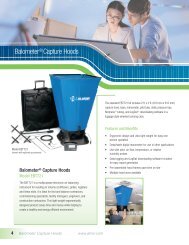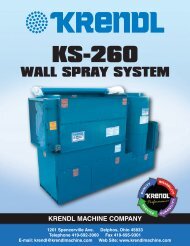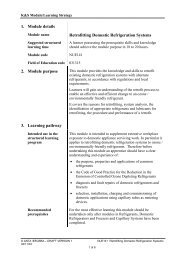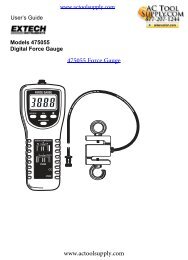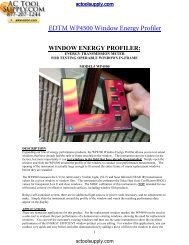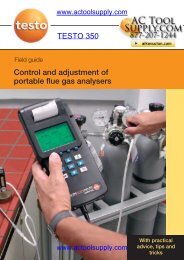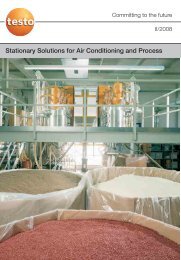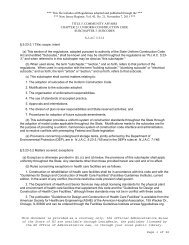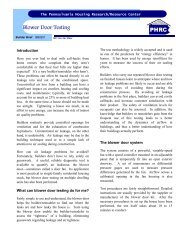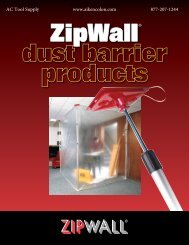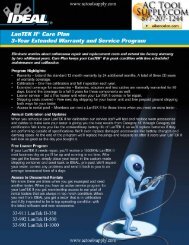MILLER DURAHOIST The - Honeywell Safety Products
MILLER DURAHOIST The - Honeywell Safety Products
MILLER DURAHOIST The - Honeywell Safety Products
Create successful ePaper yourself
Turn your PDF publications into a flip-book with our unique Google optimized e-Paper software.
USER INSTRUCTIONS - ENGLISH<br />
1.0 General Requirements<br />
Connecting Devices<br />
•Use only lanyards containing locking snap hooks or<br />
auto-locking carabiners.<br />
•Always visually check that each snap hook and<br />
carabiner freely engages the D-ring or anchor point,<br />
and that its keeper is completely closed and locked.<br />
•Connect in a manner that limits free fall to the<br />
shortest possible distance (6ft / 1.8m maximum).<br />
•Shock absorbers can elongate up to 3.5ft (1.07m).<br />
This elongation distance must be considered when<br />
choosing an anchorage point.<br />
•Connect in a manner which ensures a lower level will<br />
not be struck should a fall occur.<br />
•Do not tie knots in lanyards.<br />
•Never disable or restrict a locking keeper or alter<br />
connecting devices in any way.<br />
•Do not wrap lanyards around sharp or rough edges.<br />
Use a cross-arm strap, tie back lanyard or other<br />
compatible anchorage connector and connect to the<br />
back of the D-ring of the harness.<br />
•Do not allow rope or webbing to come in contact with<br />
high temperature surfaces, welding, heat sources,<br />
electrical hazards, or moving machinery.<br />
•A shock absorbing lanyard, self-retracting lifeline or<br />
other equipment specifically designed for fall arrest<br />
must be used as a connecting device.<br />
•Never use natural materials (manila, cotton, etc.) as<br />
part of a fall protection system.<br />
•Do not connect onto an object which is not<br />
compatible with lanyard snaphooks or carabiners.<br />
•Make sure snaphook is positioned so that its keeper<br />
is never load bearing.<br />
•Do not attach multiple lanyards together, or attach<br />
a lanyard back onto itself unless it is specifically<br />
designed for that purpose.<br />
Anchor Points<br />
•Anchor points must be capable of supporting<br />
5000lbs. (22kN) or meet OSHA 1926.502<br />
requirements for a safety factor of 2 per worker.<br />
•Always work directly under the anchor point to avoid<br />
a swing-fall injury.<br />
•Never wrap lanyards around sharp or rough anchor<br />
points. Use a cross-arm strap or other compatible<br />
anchorage connector to connect lanyard snaphook.<br />
•Ensure that the anchor point is at a height that limits<br />
free-fall distance to 6ft (1.8m) or less.<br />
•Anchor point must be compatible with snaphook or<br />
carabiner and must not be capable of causing a load<br />
to be applied to the keeper.<br />
•Ensure that the anchor point is at a height that will<br />
not allow a lower level to be struck should a fall occur.<br />
•When selecting an anchorage point, always<br />
remember that shock absorbers may elongate up to<br />
3.5ft (1.07m).<br />
•Never use an anchor point which will not allow<br />
snaphook or carabiner keeper to close.<br />
Installation of Components not Offered by Miller<br />
Your mast can be used as a support structure for various types of safety devices. Some of these can mount<br />
directly to the U-bracket at the top of the mast, while others may require an adapter bracket available by Miller<br />
DuraHoist. Any accessories being used for the mast must be installed, inspected, maintained, and operated<br />
according to Miller instructions. All installations must be approved to local standards by a qualified engineer.<br />
5



